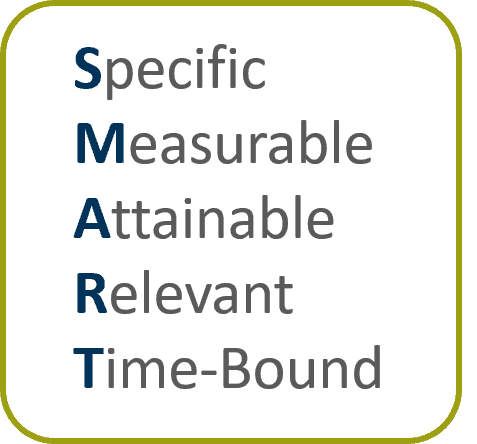How to Set SMART Goals
What are SMART Goals and Why Should We Use Them?
Often when we set goals, it’s because we want to change something about our behavior. Maybe we want to be a better listener, delegate work to others more effectively, or spend more time with family. When we set goals, it is typically because we intend to make a change. Clearly defining goals can help us identify what exactly that change is. Research in the fields of psychology, education, and health management tells us that there are steps we can take to set goals that are more likely to lead to successful changes in our behavior. These steps are often summarized by the acronym SMART.

SMART goals are those that are specific, measurable, attainable, relevant, and time-bound. They can help to clarify the steps we need to take to meet our goals, while also allowing us to measure our progress, and keep us motivated until our goal has been reached. SMART goals can be used in a variety of different contexts, including both personal and professional development. Below we describe each component of the SMART goal framework in more detail, and outline how you can start setting SMART-er goals.
Specific
The problem with many goals is that they’re too vague. Goals such as, “I want to become a better communicator” don’t do anything to describe what this looks like on a practical level. What does it mean to be a “better communicator”? Does this mean communicating more often? To more people? Using different methods? Be sure your goals are specific and make an effort to clearly define what you want to accomplish. A more specific communication goal might be “I will keep my team better informed about progress toward team objectives by sending weekly emails with status updates.”
Measurable
Once you have clearly defined your goal, it’s important to decide how you will measure your progress. At any given moment, you should know how much progress you’ve made towards your goal and how far you have left to go. Try to identify a behavior that you can track, which will help you determine whether you have reached your goal. In our communication example, think about what keeping your team “better informed” looks like. Does this mean having shorter team meetings? Fewer questions from team members? Decide what “better informed” means to you and try to attach a number to it.
Attainable
Ambitious goals, like preparing to run a marathon, are
great for describing where you want to be in the future, but they can be intimidating.
When setting SMART goals, make sure you choose a goal that is attainable. If
the goal seems unrealistic, try to break it down into smaller, more manageable steps.
Each short-term goal you achieve will help keep you on track, and these smaller
successes can keep you motivated in the pursuit of more long-term goals.
Relevant
Goals that are meaningful to you will help keep you motivated and engaged. When setting your goal, ask yourself why you want to accomplish it. What is your overall objective and how will this goal help you achieve it? In keeping with the communication example, consider how keeping your team “better informed” fits into the bigger picture of your leadership development. Will more frequent meetings or email really keep your team up-to-date, or would it be more beneficial for you to change how existing meetings are structured? Make sure the measurable goal you set for yourself will actually help you achieve your larger objective.
Time-Bound
A key component of setting SMART goals is making sure they are time-bound. While planning how you will achieve your goal, also consider when you want to accomplish it by. Research shows that specifying a time by which you’d like to complete your goal can help you maintain momentum towards achieving it. Having a deadline can provide a sense of urgency and motivate you to act. Just be sure the timeframe you choose is realistic. If it’s too short, you may not have enough time to get the work done, but if it’s too long you may find yourself procrastinating until the last minute.
How SIGMA Can Help
Scientifically validated assessments are a great way to identify your top development opportunities and serve as a great foundation for professional goal-setting. To learn more about how SIGMA’s Leadership Skills Profile-Revised and executive coaching services can be combined to support your professional development goals, contact us today.